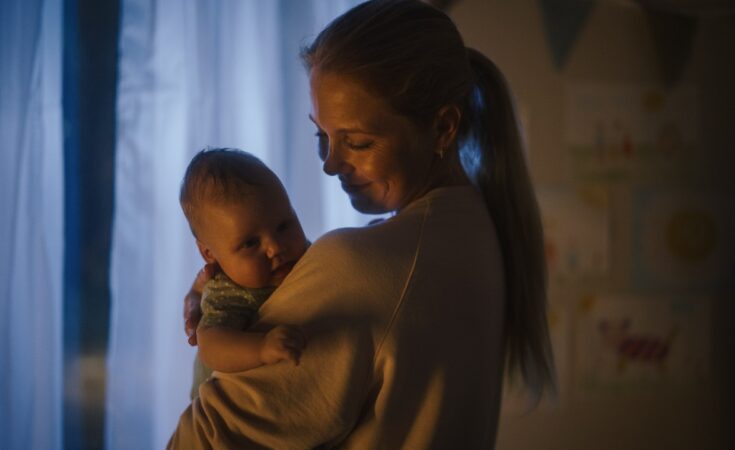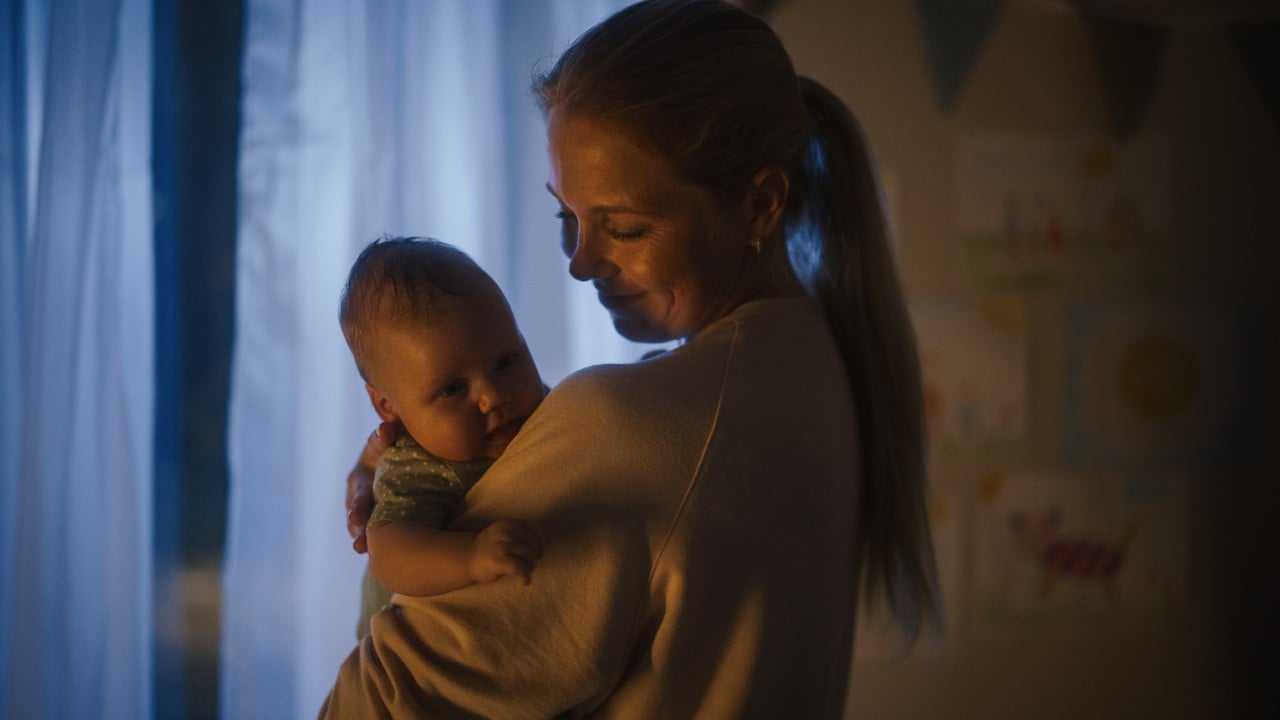He was waking every 45 minutes. I was a total mess. But as I waited for the sleep trainer’s instructions to arrive, I had an epiphany.
When my son was about four months old, I hit a week of obliterating exhaustion.
He was waking every 45 minutes, all night, every night. He’d thrash his little disoriented limbs in the bassinet, bleating a tiny note of alarm. I’d jolt awake, get up and breastfeed him back to sleep. I remember googling, Can you die from sleep deprivation?????? The three-step instructions on a box of oatmeal appeared to me as an opaque and maddening riddle.
Desperate, I signed a contract with a gentle sleep consultant. “That’s a totally normal infant sleep pattern,” she reassured me, laughing warmly. And in the next breath: “We’ll fix it.”
Should something that’s “totally normal” be “fixed”? I wondered. I shrugged it off. I was just so tired. And everyone from our paediatrician to the moms at our music class had given us the same speech: “If you don’t sleep train, your baby will never learn to self-soothe or fall asleep independently.”
But as I awaited the customized sleep plan, that moment in our conversation kept bugging me. So I started reading about why babies sleep the way they do.
Understanding baby sleep
The first thing I learned is that there are various and conflicting views on this topic! Baby sleep is controversial.
But what resonated with me the most was the belief that no matter why babies wake at night—hunger, cold, loneliness, discomfort—they need to be reassured, over and over, that their caregiver will respond. It made sense to me that that’s what helps them eventually relax enough to sleep longer stretches: They develop their own emotional regulation and self-soothing capabilities through thousands of instances of co-regulation with an adult.
I also read about the theory that the “cry it out” method doesn’t teach babies to stop having needs, only to stop communicating their needs. I stumbled into the work of James McKenna, who researches breastfeeding dyads and the secret frequency babies and their mothers share in their sleep when they practice safe bedsharing, intuitively responding to each other’s movements, a quiet dance in the dark. On Instagram, I found a vast and vocal community who believe in honouring baby sleep and refusing to tamper with nature. I devoured articles and e-books from The Beyond Sleep Training Project, hey sleepy baby, Raised Good, and Isla Grace Sleep, fascinated and hugely relieved. It felt like I’d found permission to do what felt intuitively right.
Sleep training begins—sort of
The sleep lady’s plan arrived in my inbox: a manifesto of instructions and rules. Naps had to be timed to the minute. He should be dressed in a certain number of layers, his room should be a specific temperature and shade of darkness, and white noise had to play at a strict decibel level at an exact distance from his ears. But to me, the most unhinged part was that I was “allowed” to hold him for a predetermined number of minutes before putting him down. I scoffed. How had I drifted so far from my own innate maternal wisdom that I was paying a random stranger to dictate when it was “okay” for me to hold my baby?
The next day, at nap time, I watched my son fall asleep against my chest, milk-drunk and happy and safe. His miniature eyelashes fluttered, his tiny fist gripped my finger. But the timer on my iPhone kept tugging at my periphery…
Until I realized something: This is where I felt safest, too. Close and connected, providing for my baby, reveling in the secret non-verbal language only he and I speak. I chucked my phone into a laundry basket, took him down the hall into my bed, curled my body around him, and read my book while he had the deepest sleep he’d had in months.
The sleep lady required that I gradually reduce the amount of time I held my son before putting him in his bassinet. But the more intense her rules became, the more I was secretly moving farther and farther in the other direction, until days later we were teetering dangerously close to becoming this bed-sharing hippie duo who breastfed to sleep at whatever time buddy was tired and woke up whenever buddy woke up.
For all the talk and debate and conflicting theories around what babies need for optimal sleep, I could suddenly see so clearly that all my baby needed was us, and that despite the exhaustion, we were willing to give it to him. I decided to ignore all discussions of Babies In General and tune in, deeply and deliberately, to the one in front of me. I decided that the only thing to “do” about his sleep was absolutely nothing.
How it’s going a year later
My son is 18 months old now and I still sleep beside him on a floor mattress. I breastfeed him to sleep every night and every time he wakes up, which usually only happens a couple of times a night now. His sleep is still fractured, but he seems well-rested and is energetic throughout the day.
I work from home due to COVID, and I admit that letting a baby’s sleep patterns and habits evolve naturally with zero interference can feel incompatible with adult working life. I usually cobble together enough rest to be able to write, teach classes and chase a naked toddler around as he wields a broom in one hand and a hydro bill in the other. But I never know how many times I’ll be up at night. I’ve learned to put myself to bed earlier and be more selective about how much work and socializing I take on.
This is a short season of my life. It will pass in its time.
My son can’t fall asleep on his own, but I’m not concerned. I know he’ll learn this skill eventually. He won’t still need me to rock him to sleep at age 17.
As for the sleep consultant, there wasn’t anything for us to talk about after that. Her methods weren’t the right fit for me so they didn’t get me more sleep, but whew, did they ever help wake me up.
WATCH BABY GROW!
Subscribe to Today’s Parent’s baby newsletter and find out what to expect for every stage and milestone, from birth to two years.
= 0;if(!is_postback){return;}var form_content = jQuery(this).contents().find(‘#gform_wrapper_16’);var is_confirmation = jQuery(this).contents().find(‘#gform_confirmation_wrapper_16’).length > 0;var is_redirect = contents.indexOf(‘gformRedirect(){‘) >= 0;var is_form = form_content.length > 0 && ! is_redirect && ! is_confirmation;var mt = parseInt(jQuery(‘html’).css(‘margin-top’), 10) + parseInt(jQuery(‘body’).css(‘margin-top’), 10) + 100;if(is_form){jQuery(‘#gform_wrapper_16’).html(form_content.html());if(form_content.hasClass(‘gform_validation_error’)){jQuery(‘#gform_wrapper_16’).addClass(‘gform_validation_error’);} else {jQuery(‘#gform_wrapper_16’).removeClass(‘gform_validation_error’);}setTimeout( function() { /* delay the scroll by 50 milliseconds to fix a bug in chrome */ jQuery(document).scrollTop(jQuery(‘#gform_wrapper_16’).offset().top – mt); }, 50 );if(window[‘gformInitDatepicker’]) {gformInitDatepicker();}if(window[‘gformInitPriceFields’]) {gformInitPriceFields();}var current_page = jQuery(‘#gform_source_page_number_16’).val();gformInitSpinner( 16, ‘https://www.todaysparent.com/wp-content/plugins/gravityforms/images/spinner.gif’ );jQuery(document).trigger(‘gform_page_loaded’, [16, current_page]);window[‘gf_submitting_16’] = false;}else if(!is_redirect){var confirmation_content = jQuery(this).contents().find(‘.GF_AJAX_POSTBACK’).html();if(!confirmation_content){confirmation_content = contents;}setTimeout(function(){jQuery(‘#gform_wrapper_16’).replaceWith(confirmation_content);jQuery(document).scrollTop(jQuery(‘#gf_16’).offset().top – mt);jQuery(document).trigger(‘gform_confirmation_loaded’, [16]);window[‘gf_submitting_16’] = false;}, 50);}else{jQuery(‘#gform_16’).append(contents);if(window[‘gformRedirect’]) {gformRedirect();}}jQuery(document).trigger(‘gform_post_render’, [16, current_page]);} );} );]]>
Read The Full Article Here




































whoah this blog is wonderful i really like reading your articles. Keep up the great paintings! You realize, a lot of people are hunting round for this info, you could help them greatly.